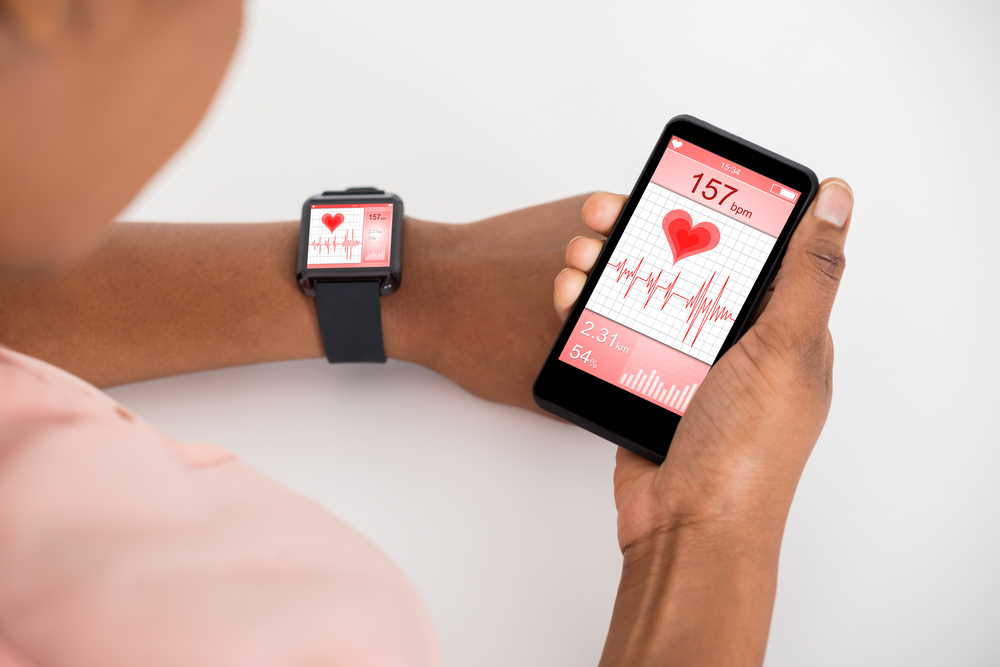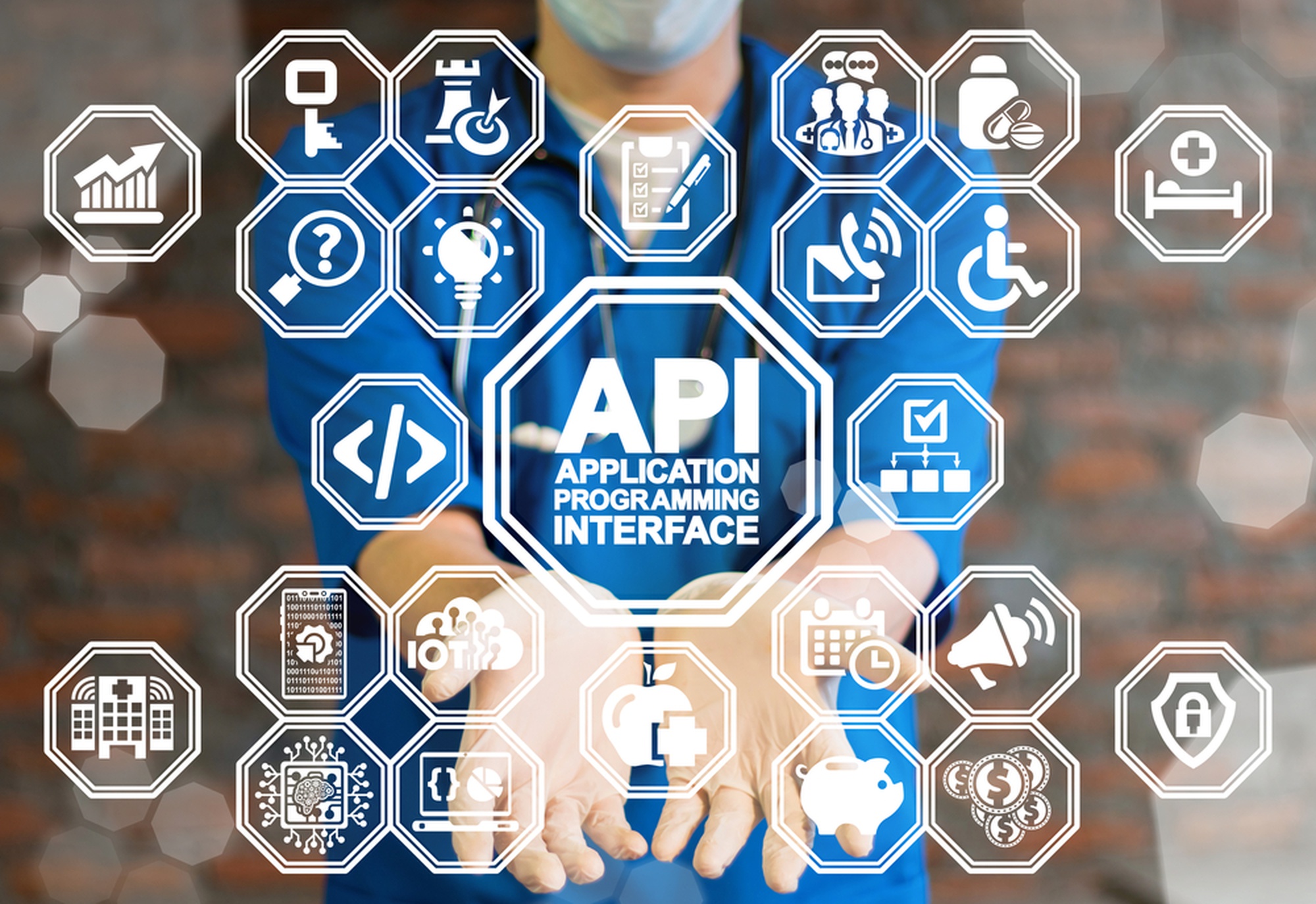A whopping 67% of patients across the US are planning to change their healthcare providers due to the insufficient sharing of health records across systems. However, some healthcare departments still rely exclusively on fax machines as a means of information exchange. What’s more, a lot of clinics are struggling to manage their processes with a variety of isolated tools that don’t communicate with each other. Luckily, medical APIs are set to fully substitute archaic tools and practices like these and enable seamless data flow.
As a healthtech provider, we’ve built a wide variety of health solutions and implemented numerous API integrations. To give you a basic understanding of healthcare APIs and their potential, we’ve distilled our experience into this article. Here, we’ll cover the main benefits and use cases for APIs in healthcare and help you understand your integration needs.
APIs in healthcare explained: what they are and how they work

An application programming interface (or an API for short) is a piece of code that helps two separate systems or applications communicate with each other for a specific task. Simply put, it acts as an intermediary whose “job” is to send requests from one party and deliver responses from the other.
But how does an API work in healthcare settings? Let’s take an example. Say one of your patients wants to integrate their nutrition app with their blood pressure and cholesterol level results. Here’s what the entire workflow would look like:
-
The patient logs into their nutrition app with their credentials.
-
After that, the patient chooses your healthcare facility from the menu and links to your EHR’s API.
-
Through the API, the nutrition app reaches out to the EHR of your facility, asking for the blood pressure and cholesterol level results of the patient. It does so using transport technology called the Hypertext Transition Protocol (HTTP).
-
Your EHR, in turn, validates the request coming through the API and sends the requested data back to the app in a compatible cross-app format, such as Javascript Object Notation (JSON) or Extensible Markup Language (XML). If the API uses OpenID Connect or OAuth 2.0 standards for authentication and authorization, it’ll ask the patient to provide their credentials (password and/or biometrical data) before delivering the requested data.
-
The app can now personalize nutrition tips based on the data retrieved from the EHR.
-
If the patient has relevant data in multiple EHRs, they can integrate this into their app, too.
A similar workflow applies to data exchange between two EHRs, as well as to linking an EHR with an inventory management system, healthcare analytics software, a hospice management solution, a pharmacy, a wearable device, and so on. But what benefits do API integrations bring to healthcare? Let’s explore this below.
Benefits of integrating healthcare APIs

As shown above, APIs are invisible “bridges” that connect data and functionalities. Given the enormous amount of patient data and the speed of innovation in the industry, the potential for the use of APIs in healthcare is huge: these pieces of code are set to revolutionize every aspect of the sector. Let’s look at hospitals, developers, and researchers as examples.
Hospitals
First, APIs can help healthcare professionals to consolidate patient data generated in their facility into one place. Second, they make sharing health information among multiple healthcare professionals easier. Gone are the days when doctors were compelled to conduct additional screenings if the patient’s lab test results were lost — now, they can access all the data via the APIs of previous providers. Finally, APIs can also enable patients to share information generated with the Internet of Things devices — such as glucose meters, blood pressure cuffs, or agetech solutions — in real-time.
With the wealth of data coming through APIs and being consolidated in one place, providers will have a 360-degree view of the patient’s condition. This will enable them to deliver more timely, more precise care without wasting patients’ time with late diagnoses and ineffective treatment.
Developers
Acting as “doorways” to data and/or features, APIs allow developers to build healthcare solutions faster and significantly reduce development costs. This is, actually, the main reason why they are gaining in popularity across industries.
For example, you don’t have to build a separate natural language processing (NLP) tool or develop a solution that can work with medical images if Google Cloud Healthcare API, which has these functionalities, seamlessly fits into your system. Likewise, there’s no need to aggregate drug data manually if the First DataBank Cloud Connector API, which provides access to medication data, is already here.
Researchers
Before the advent of APIs, researchers used lengthy questionnaires to collect the necessary health information about people that participated in clinical trials and studies. The participants had to remember all the details of their medical backgrounds, which can be a challenge for anyone. Also, any mistakes in data entry can lead researchers to reach the wrong conclusions.
With their ability to retrieve data from multiple resources, APIs give researchers a more complete and accurate overview of the participants’ health backgrounds without the need to bother anyone with daunting surveys. Besides, APIs facilitate international collaboration — otherwise, researchers would have to conduct scattered studies, and results would come much slower.
APIs in health data integration: Key standards

The healthcare industry is a highly regulated domain. But what about APIs? Let’s focus on the four main data exchange standards that apply to medical APIs.
FHIR
Devised by Health Level Seven International (HL7), Fast Healthcare Interoperability Resources (FHIR) is a new standard for medical data exchange. Basically, FHIR is a “language” designed to make data understandable across apps and organizations.
FHIR represents patient records as resources — small data sets of the same size and structure — with each resource containing a small portion of information, such as radiology scans or blood test results. FHIR APIs are mainly RESTful, meaning that they use HTTP Secure protocol and JSON or XML format.
USCDI
While FHIR says how medical data should be transported and how it should be structured, USCDI, or United States Core Data for Interoperability, focuses on what information should be shared via FHIR APIs at the patient’s request. USCDI covers a variety of data classes, such as allergies and intolerances, immunizations, health concerns, and beyond.
Security standards (HIPAA and GDPR)
Probably, the majority of healthcare APIs transmit protected health information (PHI), which is any health information that can identify a person. Given that, when building or choosing an API for your solution, make sure that it complies with all obligatory standards that protect PHI in your location.
For example, in the US, PHI is secured by HIPAA, or the Health Insurance Portability and Accountability Act, which outlines technical safeguards that must be in place for efficient data breach prevention. In the European Union, this type of information is covered by GDPR, the General Data Protection Regulation.
SMART on FHIR
SMART (Substitutable Medical Apps & Reusable Technology) on FHIR describes how EHRs can safely exchange FHIR data with third-party apps. The latter include both standalone health solutions and those integrated into EHRs. Among the other things, SMART on FHIR apps use OAuth2 and Open ID Connect protocols for secure authorization.
Though SMART on FHIR is a concept that focuses on secure data exchange, it doesn’t require compliance with HIPAA, GDPR, or other security standards.
How are APIs used in healthcare?

As a healthtech provider, our experience building and integrating medical APIs has shown us that their linking power can be applied to any aspect of the healthcare industry. We hope that these four examples of healthcare API use cases will be enough to show you that the technology gives providers endless opportunities.
Integration of healthcare operations
Healthcare providers collect large amounts of health-related data. Physician notes, lab test results, and radiology scans are just a few examples. And then there’s all the non-medical information, such as patient billing details. Like it or not, all this information impacts the quality of care and patient outcomes.
But the variety of information is just the tip of the iceberg. In large healthcare facilities, all this wealth of data is, more often than not, scattered across several systems — each one leveraged by the corresponding department (for example, one system for the front office, one for the emergency room, one for the anesthesiology department, and one for the rehabilitation unit). The same problem applies to cases that involve independent healthcare facilities.
And that’s where APIs come into play. They can help you link and coordinate these disconnected datasets and avoid data silos both within one healthcare organization and between multiple healthcare facilities.
Remote care
Remote care services is an umbrella term that covers data exchange between physicians and patients, telemedicine, and also appointment scheduling and lab test booking via patient-facing solutions. And since APIs are about all things remote, they come in handy here. For example, GluVue uses APIs to collect data from glucose monitors and securely import it into your EHR, allowing for continuous blood glucose monitoring no matter where your patients are.
There’s a whole variety of off-the-shelf APIs that will augment your health solution with remote care functionalities.
For instance, DrChrono, an EHR system with telehealth capabilities, offers an API for building innovative healthcare applications. Another example is Bluestream API, which also enables providers to integrate virtual case features into their healthcare platforms.
Patient-facing app experiences
With simpler access to healthcare data, developers can now create health app experiences with an unprecedented level of personalization. For example, with the help of the Apple Health Records API, Medisafe users can import their prescription list directly from their EHR without manual entry to quickly enable pill reminders and enjoy other features of the app. They can also consolidate medication lists from multiple healthcare facilities and enable warnings about dangerous drug–drug interactions.
Research and global knowledge sharing
There are a variety of APIs that have the potential to promote global knowledge sharing and accelerate innovation in healthcare. As a case in point, the Global Health Observatory, a portal built by the World Health Organization (WHO) to collect health statistics by country, shares its data with third-party apps via the Athena API. Another example is the Content Syndication API, which consolidates news, surveys, and other data from the US Department of Health and Human Services’ partners and shares it with apps, websites, and beyond.
10 best healthcare APIs for 2022

Due to the increasing need for seamless workflows between various healthcare systems, the medical API market is expanding with a projected CAGR of 6.3%. Below are some of its top offerings — consider them if you want to choose an API for your healthcare system.
Epic USCDI on FHIR API
Epic is the leading EHR software vendor in the US with around 34% market share. So, if you are a US healthcare provider, there’s a big chance that your EHR is running on Epic. And the most amazing thing here is that if you want to build, say, a telemedicine app dependent on your EHR data, you don’t need to move your patient records to your app manually — instead, all you have to do is to integrate your solution with the Epic USCDI on FHIR API.
The Epic USCDI on FHIR API allows developers to retrieve over 50 text data elements — within and beyond the USCDI set — in FHIR format for building lightweight provider-facing, and in some cases patient-facing, health solutions. Also, Epic offers a dedicated sandbox, enabling developers to test integrations before they go live.
Cerner Ignite APIs
With a database of about 100 million patient records, Cerner is the second-most popular US EHR provider with multiple APIs. All in all, Cerner Ignite APIs feature over 30 FHIR data resources, which are available free of charge and can be read, and in some cases, searched, created, and updated. These APIs are perfect for building both provider- and consumer-access solutions.
Apart from standard healthcare APIs allowing you to link an EHR to your app, Cerner also offers a separate API (for business-to-business projects) that gives access to Healthelntent — a platform that aggregates patient health data from various sources in real-time.
All solutions that are linked to Cerner Ignite APIs must undergo validation, which takes from 10 to 14 weeks. The company can run your app against security, functionality, operational, and usability tests for an additional fee.
Apple Health Records API
While Epic and Cerner Ignite APIs retrieve records from Epic or Cerner EHRs, there are a wide variety of “vendor-agnostic” APIs for healthcare that give access to data from various sources. Apple Health Records API is one of them. It covers over 500 healthcare facilities across the US, allowing iOS users to access their medical records organized into a single view and link this data to their favorite apps.
By integrating apps with Apple Health Records API, developers can personalize user experiences in a variety of mobile health solutions for medication tracking (pill reminders), disease management, nutrition planning, and beyond. When at rest, Health Records data is protected with the patient’s iPhone passcode, Touch ID, or Face ID and encrypted. When in transit, it “travels” directly from HealthKit to the third-party app. On top of that, users are notified every time new medical data arrives.
Human API
No listing of health API examples is complete without Human API.
Human API gives developers and healthcare providers a simple way to connect the health data needed to deliver their services, platforms, and health apps. It connects to over 40,000 sources — including EHR systems, labs, pharmacies, and patient portals, as well as wearable electronic devices and fitness apps — and covers over 264 million patients. It gives access to a variety of data elements, from allergies and immunizations to genetic traits and patients’ sleep habits, which are then converted into an FHIR-compatible format.
MyHealthfinder API
MyHealthfinder is a trusted disease prevention and wellness source in the US. It gives users personalized health tips based on their sex, age, and habits, which are reviewed and updated by the Office of Disease Prevention and Health Promotion (ODPHP). If you are looking to augment your solution with a similar recommendation engine to empower your patients, you can use MyHealthfinder Content API instead of building anything from scratch.
Google Cloud Healthcare API
Apart from being a gateway to patient data, a medical API can also serve as a source of advanced features. For example, Google Cloud Healthcare API can arm your solution with a variety of tools for working with medical data, including:
-
extracting data from different sources, including wearable devices
-
NLP (natural language processing) engine for unstructured data analysis
-
converting medical data into FHIR resources
-
working with medical imagery (files in the DICOM format)
-
consolidating data in different forms into a single document
-
and beyond
With Google’s API, you can implement medical decision-support solutions, tools for precision medicine, and more.
First Databank Cloud Connector API
Medications are a vital component of most patient treatment workflows. But where can you get trustworthy and up-to-date information on drugs and seamlessly integrate it into your processes?
That’s where solutions like First Databank come into play. Its drug database MedKnowledge includes drug images, dosing data, various drug interactions, and so on. With the First Databank Cloud Connector API, you can build pharmacy management systems, clinical decision-support modules, treatment adherence apps, and other solutions that leverage the resources of MedKnowledge.
FDA
Since the “journey” of every drug product begins with registering with the US Food and Drug Administration, the FDA database is a valuable source of medication data. And fortunately, you can make use of it via openFDA APIs, which give access to NDC (National Drug Code) numbers of drugs marketed in the US, reports on medical errors and adverse events, data on drug recalls, and more.
DrChrono
DrChrono is an EHR software provider that offers a free API kit to developers worldwide willing to enhance the functionality of the DrChrono platform or even create separate medical solutions. Some of the latest features of the API include:
-
Webhooks that “inform” your app about changes in the DrChrono EHR and trigger data exchange
-
Clinical Notes Endpoints that allow medical notes to be in one place during patient visits
-
Labs APIs Endpoints that enable providers to build modern lab workflows properly into EHRs
DrChrono also provides an API support team to help healthcare providers and their development teams improve their solutions.
Intermedica API
Intermedica is a diagnosis API that can be integrated with websites, apps, and telehealth systems.
Intermedica uses an NLP engine to recognize symptoms in patient messages, and its knowledge base counts 1,360 symptoms and 740 conditions. According to providers of the API, Intermedica “speaks” 19 languages and is 93% precise in its diagnoses. What’s more, since it’s powered by machine learning technology trained on millions of anonymous patient records, Intermedica’s accuracy levels improve as it collects more data.
Deciding on the API strategy for your healthcare solution
With the capability of APIs to connect to different systems, integrating them into your patient- or provider-facing solution will allow you to take it to the next level without reinventing the wheel.
But how can you be sure that your REST API for healthcare complies with all the industry standards and will fit seamlessly into your system? Or what about integrating multiple APIs and making sure they work properly? Or finally, which API is ideal for, say, augmenting your health analytics app with data visualization capabilities? And that’s to say nothing about custom healthcare API development.
At Demigos, we’ll answer all your questions and concerns regarding APIs for healthtech. What’s more, whether you are looking to integrate an API into your system or build your own API to market it to other healthcare providers, you can rely on our expertise — just get in touch!






